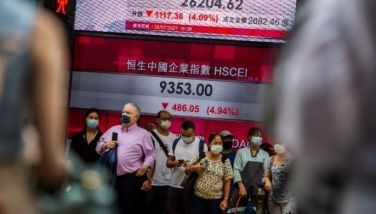Slower growth, weaker peso seen this year due to election-related risks
January 17, 2007 | 12:00am
The country’s gross domestic product (GDP) is forecast to grow by a slower 4.7 percent this year and 4.5 percent in 2008 after an estimated 5.9-percent expansion in 2006, a leading global financial institution said.
The global research arm of Standard Chartered Bank (SCB) said in a report that the peso is also expected to weaken to an average 50 to the dollar this year, before strengthening back to at 48:$1 in 2008.
SCB pointed out that investors would require a higher risk premium with the coming National elections in May, with the greater risk on the possibility that the opposition would gain majority control in the elections, leading to another series of impeachment efforts against President Arroyo.
"The risk, which seems not particularly high though, is if Arroyo’s hold of power turns more fragile leading to abrupt change in the government, then investor confidence could be negatively affected," the SCB report said.
It added that regional risk appetite could result in the reversal of positive gains by the Philippines. "Historically, the Philippines is vulnerable to market volatility triggered by falling confidence in emerging markets, which may see higher volatility as global growth and interest rate cycles turn."
Nevertheless, consumption will continue to sustain the progressive march of the Philippine economy, buoyed mainly by remittance inflows from overseas Filipino workers (OFWs) and migrant Filipinos, the SCB said.
Filipinos working in the US remains the biggest contributors of foreign remittances, with Europe seen increasing its share in terms of value. Europe is attracting professionals and blue-collar employment resulting in higher-value remittances.
The Middle East and Asia are the other areas that have considerable volumes and values in terms of remittances.
Total remittances in 2005 reached over $10 billion, and is expected to contribute another $12 billion to $13 billion in 2006.
Meanwhile, headline inflation is seen to edge down gradually, averaging 4.8 percent in 2007. "We expect the Bangko Sentral ng Pilipinas (BSP) to start easing inflation measures in the second quarter of the year," SCB said.
On the other hand, exports are expected to decelerate to a 6.8-percent growth this year from the 16 percent growth realized last year.
Imports are likewise forecast to weaken slightly to 7.8 percent this year from the anticipated 9.2 percent last year.
The global research arm of Standard Chartered Bank (SCB) said in a report that the peso is also expected to weaken to an average 50 to the dollar this year, before strengthening back to at 48:$1 in 2008.
SCB pointed out that investors would require a higher risk premium with the coming National elections in May, with the greater risk on the possibility that the opposition would gain majority control in the elections, leading to another series of impeachment efforts against President Arroyo.
"The risk, which seems not particularly high though, is if Arroyo’s hold of power turns more fragile leading to abrupt change in the government, then investor confidence could be negatively affected," the SCB report said.
It added that regional risk appetite could result in the reversal of positive gains by the Philippines. "Historically, the Philippines is vulnerable to market volatility triggered by falling confidence in emerging markets, which may see higher volatility as global growth and interest rate cycles turn."
Nevertheless, consumption will continue to sustain the progressive march of the Philippine economy, buoyed mainly by remittance inflows from overseas Filipino workers (OFWs) and migrant Filipinos, the SCB said.
Filipinos working in the US remains the biggest contributors of foreign remittances, with Europe seen increasing its share in terms of value. Europe is attracting professionals and blue-collar employment resulting in higher-value remittances.
The Middle East and Asia are the other areas that have considerable volumes and values in terms of remittances.
Total remittances in 2005 reached over $10 billion, and is expected to contribute another $12 billion to $13 billion in 2006.
Meanwhile, headline inflation is seen to edge down gradually, averaging 4.8 percent in 2007. "We expect the Bangko Sentral ng Pilipinas (BSP) to start easing inflation measures in the second quarter of the year," SCB said.
On the other hand, exports are expected to decelerate to a 6.8-percent growth this year from the 16 percent growth realized last year.
Imports are likewise forecast to weaken slightly to 7.8 percent this year from the anticipated 9.2 percent last year.
BrandSpace Articles
<
>
- Latest
- Trending
Trending
Latest
Trending
Latest
Recommended

























